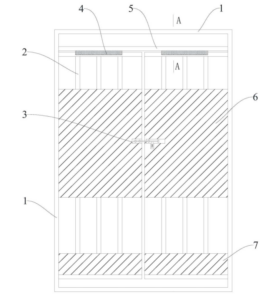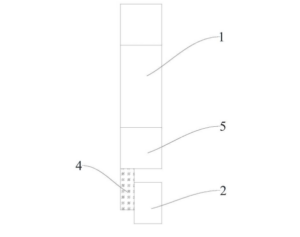Background
In the construction process of high-rise buildings now, all need to arrange outdoor construction elevators, and the construction elevator is arranged on the outer wall of the building. Each floor of the building is provided with a reserved opening opposite the construction elevator, that is, the elevator entrance, and construction personnel can enter each floor of the building through the elevator entrance from the construction elevator. Elevator doors are arranged at each elevator entrance, and the elevator doors have two door leaves, which are usually fixed by bolts between the two door leaves. However, due to the high height of the outdoor elevator, the bolts cannot completely fix the two door leaves firmly. Under the repeated impact of wind force, the elevator door leaves will shake irregularly, causing the bolts to fall out of the sockets, and then the elevator doors will automatically open, posing a safety hazard. If the bolt fixing method is changed to other structures such as door locks, the time for opening and closing the elevator door will be prolonged and work efficiency will be reduced.
Working principle
Magnetic self-priming construction elevator protection door, by setting a magnet on the door frame, the door leaf can be firmly adsorbed on the door frame after the door is closed, it is not easy to shake when the wind blows, and the door leaf will not open due to the wind blowing. With the use of the latch, it ensures that the door leaf can be firmly within the scope of the door frame, and can only be opened when the construction personnel actively open it, which reduces the potential safety hazards caused by the automatic opening of the door leaf and improves the safety of construction operations.
Fig.1 is the structural representation of the magnet self-priming construction elevator protection door involved in an embodiment of the present utility model, and Fig.2 is the structural representation of A-A section in Fig.1: 1, door frame; 2, door leaf; 3, latch; 4. Magnet; 5. Connecting rod; 6. Protective plate; 7. Skirting board.


Door frame 1 is fixed at the reserved opening of the building when in use and faces the construction elevator. When the construction elevator runs to the reserved opening, the construction personnel can enter the interior of the building through the protective door. A magnet 4 is arranged on the top of door frame 1, which can be used to assist in fixing door leaf 2. The side of door leaf 2 is hinged on the door frame 1, which is a side-by-side door structure. The top of door leaf 2 is made of ferromagnetic metal or is provided with a ferromagnetic metal sheet facing magnet 4, which can be fixedly connected to the door frame 1 under the adsorption of the magnet. , can resist a certain amount of wind force, and prevent the door leaf 2 from shaking under the effect of wind. The latch 3 includes a pin body and a pin hole, wherein the pin body is slidably arranged on one door leaf 2, and the pin hole is arranged on the other door leaf 2 and is opposite to the pin body. When the pin body is inserted in the pin hole, it can prevent the external force from opening the two door leaves 2 and improves the safety of the protective door.
When the protective door of the self-absorbing construction elevator with magnets is in use, it will not shake even under the action of wind force, thus avoiding the opening of bolt 3 caused by the shaking of door leaf 2, and improving the safety performance of protective door.



